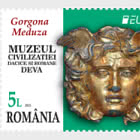Romfilatelia, the company specialized in editing and trading Romanian postage stamps, introduces into circulation the postage stamp issue ROMANIAN POTTERY – Pots and cups (II). Pottery has been practiced as early as ancient times, a fact supported by such evidence as the beautiful ceramic vessels from the Neolithic period, an epoch when a remarkable civilization was developed on the Romanian territory.
The ornamental motifs with which the plates are decorated are basically geometrical, but also phytomorphic, avimorphic, zoomorphic and anthropomorphic. One of the oldest decorative geometrical motives is the triangle, which is also encountered on the prehistoric ceramics and appears in different forms (a series of triangles of the same size), "the saw" or "the wolf’s fang" (triangles arranged alternatively up-down). The spiral particularly appears on the old ceramics of Cucuteni and Boian, but also on the
plates moulded in Vama, Horezu, Oboga, Romana etc. usually made from white clay. The spiral, although a very old motif, cannot be found in the occidental ceramics of the same period, not even in the later ones, such as the Mediterranean potteries.
Along with the beanstalk and garlands, the fir-tree tweak is often encountered as a phytomorphic motive, also used in the prehistoric pottery. The fir-tree tweak symbolizes the perenniality associated to the tree (life tree). The vine (a Christian symbol), and also wheat ears, clovers, clusters of grapes, buds, stylized leaves and flowers are also represented. The avimorphic, zoomorphic and anthropomorphic motives are more rare and more recent and belong to the Byzantine tradition. Doves, fowls, fishes (Christian symbols) are represented. Of particular interest are the symbolic motives connected to ancient, pre-Christian beliefs, associated to the cult of the Sun, which replaced the one of fecundity from the Bronze era.
On the stamp with the face value of Lei 2.10 we find a pot handcrafted in Transylvania.
On the stamp with the face value of Lei 3.10 we find a cup made in Horezu-Valcea.
On the stamp with the face value of Lei 7.20 we find a cup crafted in Obarsa-Hunedoara.
On the stamp with the face value of Lei 8.70 we see a pot made in Baia Mare-Maramures.











































